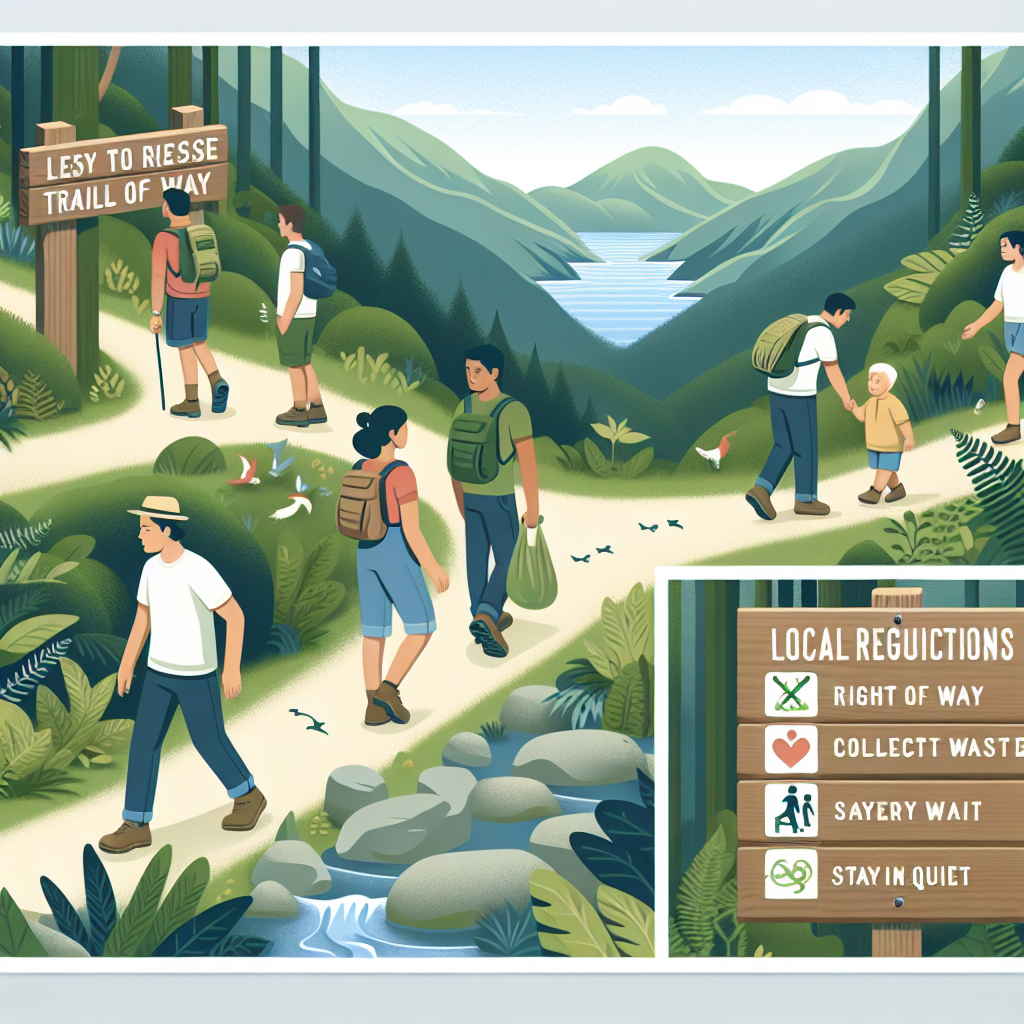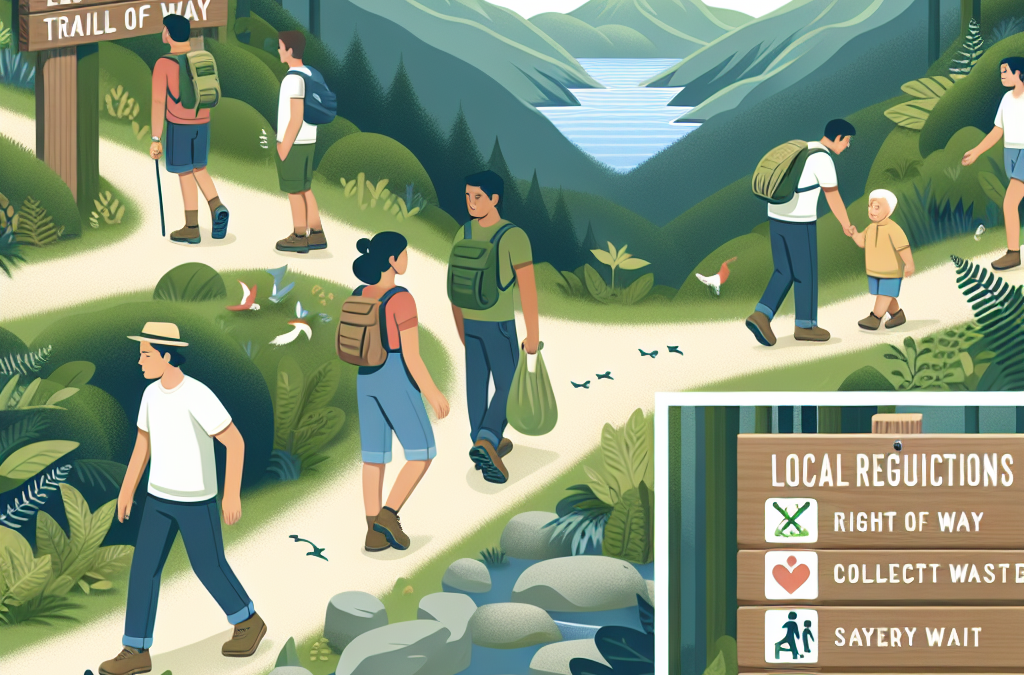You’re about to embark on a splendid journey through an article titled “Hiking Etiquette: Sharing The Trails Responsibly.” Imagine every hike you take as an opportunity to immerse yourself in nature’s majestic creations while respecting the environment and fellow hikers. This article is dedicated to helping you understand proper hiking etiquette and how to share the trails responsibly, ensuring a positive experience for you and everyone else involved. Let’s get ready for a beautiful trek!

Understanding Hiking Etiquette
Hiking is a recreational activity enjoyed by millions around the world. But like any outdoor activity, it comes with its own unique set of rules and conventions, or “hiking etiquette”. This isn’t just to keep people happy, it’s essential to maintain harmony among all the stakeholders of the trail- other hikers, nature, and wildlife. So, let’s embark on a journey to understand the world of hiking etiquette.
The importance of trail etiquette
What makes hiking so deeply cherished is the opportunity to experience nature in its most raw form. However, this natural wonder is a delicate balance of ecosystems that can easily be thrown off-balance by human interference. And trail etiquette is about making human interaction with the wilderness as respectful and non-disruptive as possible. It keeps trails enjoyable and safe, maintains peace among trail users, protects native wildlife, and ensures that future generations can have the same awe-inspiring experiences.
The basic principles of responsible hiking
Responsible hiking revolves around respect- for nature, for wildlife, and for other people using the trails. This includes staying on designated paths, leaving no trace of your presence, keeping a safe distance from wildlife, being discreeat with noise levels, giving right of way where necessary, being prepared for emergencies and effectively managing pets on the trail, if they are permitted. In essence, responsible hiking means enjoying your exploration without compromising the trail and its occupants in any way.
Respecting Other Trail Users
Hiking trails are shared spaces, meant to be enjoyed by everyone. Respecting other trail users is a fundamental of hiking etiquette.
How to respect fellow hikers
Firstly, always greet your fellow hikers with a friendly nod or a hello. It fosters a sense of community on the trails. If you’re hiking a popular route, let faster hikers pass you by stepping to the side of the trail. Respect the quietude and tranquility that other hikers may be seeking.
Proper behavior around cyclists and horseback riders
Cyclists and horseback riders are also frequent users of hiking trails. Bicyclists should yield to hikers and horseback riders. For horses, since they are often startled easily, it’s best to step aside and let them pass. Ensure to make your presence known gently and always ask the rider for direction before approaching a horse.
Being considerate of wildlife
A cardinal rule of outdoor etiquette is respecting wildlife. Your hiking experience should not disturb the local flora and fauna. Always observe them from a distance. Never feed wild animals, as it alters their natural behavior and can lead them to become reliant on human food. Avoid loud noises that can cause distress to wildlife.
Trail Right-of-Way
Understanding trail right-of-way is an essential aspect of hiking etiquette. It helps in avoiding conflicts and confusion on the trail.
Determining who has the right-of-way
In general, the downhill hiker yields to the uphill hiker. This is because the uphill hiker usually has a limited field of vision and may be in a rhythm or flow. However, sometimes, an uphill hiker may want to take a breather and will indicate for you to pass.
Giving way to uphill hikers
If you encounter an uphill hiker, you should step to the side of the trail and make yourself known verbally to avoid any surprise encounters.
What to do when encountering livestock and pack animals
Livestock and pack animals have the right of way. When you see livestock or pack animals approaching, step off the trail on the downhill side and remain quiet until they pass. This prevents the animals from getting spooked and running uphill, potentially causing rockfalls or other dangers.
Trail Communication
Good communication is vital for sharing the trail responsibly and safely. Verbal and non-verbal cues help inform other trail users of your actions and intentions.
How to communicate effectively on trails
Communication on trails can take many forms. It can be as simple as a greeting to signal your presence, hand signals indicating your intentions, or quietly making your presence known to wildlife. It is a crucial way to show respect and consideration to others utilizing the same space.
The significance of voice and visual cues
Voice and visual cues are not just polite, they’re also essential for maintaining safety on the trail. They help prevent accidents and confusion, particularly in tricky terrain or during high traffic periods on the trail.
When to use bells and whistles
While the trail should be a peaceful sanctuary, sometimes it’s necessary to use bells and whistles to communicate more effectively when you find visibility poor or in corners with blind spots to avoid startling another hiker or an animal. But remember, this practice should be used sparingly and only when needed.

Maintaining Noise Levels
One of the best parts of hiking is the opportunity to immerse yourself in the quiet tranquillity of nature.
Why keeping noise levels down is important
Keeping your noise levels to a minimum keeps the trail peaceful for everyone and reduces the disturbance to wildlife. Excessive noise can stress animals, altering their natural behavior and potentially making them dangerous.
How to enjoy nature without disturbing it
Enjoy nature quietly. This means no yelling, no loud music, and keeping the volume of your voices down. Instead, take the time to listen to the rustling leaves, the chirping birds, the wind racing through the treetops, and the stream trickling along the trail side.
Respecting the silence sought by other hikers
Keep in mind that many people visit wilderness areas for the peace and solitude they offer. So your noise shouldn’t be the factor that interferes with another person’s experience. Respect the silence as much as you enjoy it.
Hiking in Groups
Hiking in groups can be a fantastic experience, but it’s important to consider how your group’s activity might impact other trail users and the environment.
Appropriate behavior when hiking in groups
Try to keep your group to a manageable size that is less likely to result in unnecessary trail damage or disturb other hikers. Always keep your group together so as not to deny the right-of-way to other trail users. Lastly, keep the noise level down.
Maintaining trail etiquette as a group
Just like a solo hiker, groups must adhere to trail etiquette. That means following all the basic principles of responsible hiking. If your group is large, consider making way for solo hikers or smaller groups. Leave some space between individuals to prevent crowding the trail.
Planning group hikes that respect the trail and other users
When planning a group hike, take time to educate everyone going on the hike about trail etiquette. Choose trails that are designed to sustain heavy use. Try to avoid hiking at peak times to mitigate overcrowding on the trail.
Protecting the Environment
Through hiking, we get a close encounter with the environment. But our awe-inspiring surroundings could be ruined if we don’t take steps to protect them.
Adhering to ‘Leave No Trace’ principles
The most critical principle of hiking etiquette is to ‘Leave no trace.’ This means leaving your surroundings exactly as or better than you found them. Be mindful of trash, food waste, and any other potential pollutants.
Respecting wildlife and plant life
Keep a respectful distance from wildlife. Never feed wild animals. Do not pick flowers, disturb rocks, excavate, or alter any natural features on the trail. In short, let nature remain unadulterated.
Sticking to designated trails
Use only established trails and campsites. Stick to the middle of trails to avoid trampling vegetation and causing erosion. Always remember, each step off-trail can cause damage that may take years or even decades to recover.
Hiking with Pets
Hiking with pets can add to the joy of a day out in nature, but it’s essential to manage your pet responsibly.
Understanding the rules when hiking with dogs
Certain trails may require dogs to be kept on a leash or might not allow dogs at all. Always check the rules before you hit the trail. Clean up after your dog to prevent possible pollution and disturbance to wildlife.
Managing pets responsibly on the trail
Ensure that your pet respects wildlife and other people on the trail. This implies training them for situations they may encounter on the trail. Avoid taking pets to areas with sensitive ecosystems as even the best-behaved pets can cause unintentional stress to local fauna.
Respecting other trail users’ space when hiking with pets
Dogs, whilst loved by many, can be a cause of concern for others. Keep your dog by your side and never assume that everyone else is comfortable with your furry friend. Make sure to keep your dog under control at all times to respect the comfort and safety of others.
Dealing with Waste
Responsible waste disposal is a significant part of hiking etiquette. Litter is an eyesore at the least, and at worst, it can be damaging to the trail ecosystems and hazardous to wildlife.
Properly disposing of waste
Whether it’s food wrappers, fruit peels, or water bottles, always carry your trash with you and dispose of it properly off the trail. Also, take the time to pick up any litter you might see. This is a crucial part of the ‘Leave no Trace’ principle.
Understanding the impact of one’s waste on the trail
Waste left on the trail can cause serious ecological harm. It’s not just unsightly; it can attract wildlife, leading them to become dependent on human food. Also, many items can take years to biodegrade, harming plants and the quality of the water in the area.
Carrying out what you carry in
Whatever you carry onto the trail, take it back when you leave. This rule applies not only to trash but also to any natural objects like rocks, plants, or feathers you may find. The wilderness is not a take-away spot. What’s natural must remain natural.
Emergency Situations
Even on our best days, emergencies can happen. Dealing with them responsibly is part of hiking etiquette.
Knowing how to handle emergency situations
Before you hit the trails, get acquainted with basic first aid and emergency procedures. Carry a first-aid kit. Stay calm and focused during emergencies and communicate clearly to get help.
Proper reporting of emergencies
If a situation arises beyond your control, report it. Most parks and wildlands have rangers on duty who can handle such incidents. Accurately reporting emergencies helps keep trails safe for everyone.
Respecting trail closures and emergency signs
Trail closures and emergency signs are there for a reason. Respect these indications and alter your plans accordingly. It keeps you safe and reduces the strain on park rangers and emergency response units.
So, that was an overview of hiking etiquette. It might seem like a lot but when broken down, it’s just about simple respect and common sense. Hiking is a privilege; let’s make sure we’re doing it right! Happy trails to you.

